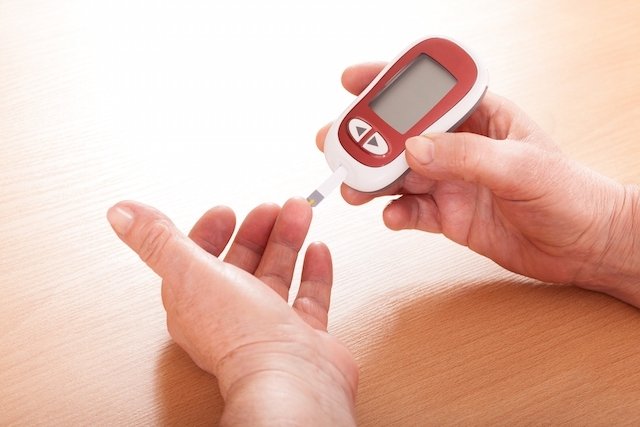A glucometer is a device used to measure blood glucose levels, and is mainly used by people who have type 1 and 2 diabetes, as it allows them to know their sugar levels throughout the day.
Glucometers can be easily found in pharmacies and their use should be guided by a general practitioner or endocrinologist, who will indicate the frequency of blood glucose measurements.

What is it for
The purpose of using a glucometer is to assess blood sugar levels, being useful in diagnosing hypo and hyperglycemia, as well as being important for checking the effectiveness of treatment against diabetes. Therefore, the use of this device is mainly recommended for people who have been diagnosed with pre-diabetes, type 1 diabetes or type 2 diabetes.
The glucometer can be used several times a day, which may vary according to the person’s diet and type of diabetes. Typically, pre-diabetic people and people with type 2 diabetes need to measure their glucose 1 to 2 times a day, while people with type 2 diabetes who use insulin may need to measure their glucose up to 7 times a day.
Although using a glucometer is useful for monitoring diabetes, it is also important that the person undergoes routine blood tests to check whether there are any signs indicating a complication. See which tests are recommended for diabetes.
How it works
Glucometers are easy-to-use devices and should be used in accordance with the recommendation of a general practitioner or endocrinologist. The functioning of the device varies according to its type, and it may be necessary to make a small hole in the finger to measure blood sugar levels or it may be a sensor that performs the analysis automatically, without the need to collect blood.
Common glucometer
The common glucometer is the most used and consists of making a small hole in the finger of the hand, with a device similar to a pen that has a needle inside. Then, the reagent strip must be wetted with blood and then inserted into the device so that the glucose level can be measured at that moment.
This measurement is possible due to a chemical reaction that occurs in the tape when it comes into contact with blood. This is because the tape may contain substances that can react with the glucose present in the blood and lead to a change in the color of the tape, which is interpreted by the equipment.
Thus, according to the level of the reaction, that is, the amount of product obtained after the chemical reaction, the glucometer is capable of indicating the amount of sugar circulating in the blood at that moment.
FreeStyle Libre
The FreeStyle Libre is a more recent type of glucometer that consists of a device that must be placed on the back of the arm, remaining in place for approximately 2 weeks. This device measures glucose levels automatically, without the need to collect blood, providing information about current blood glucose levels over the last 8 hours, as well as indicating the trend in blood glucose levels throughout the day.
This glucometer can check blood glucose continuously, indicating when it is necessary to eat something or use insulin, avoiding hypoglycemia and preventing the development of complications related to decompensated diabetes. Find out what the complications of diabetes are.
The equipment is discreet and it is possible to take a shower, go to the pool and go into the sea because it is resistant to water and sweat, and therefore does not need to be removed until it runs out of battery, after 14 days of continuous use.
Bibliography
- Methods for assessing glycemic control. Brazilian Diabetes Society. 110-119, 2013-2014
- RING, Hannah Paula B.; FAUSTINO, Tassia N.; FAUSTINO, Thaillan N.; STONE,, Larissa Chaves. Glycemic values offered by the portable glucometer, using blood from different collection routes: validity study . Rev Bras Ter Intensiva. Vol 22. 4 ed; 351-357, 2010
- SANTOS, Márcia MA Case Study – glucometer. 2013. Available at: <https://www.saude.pr.gov.br/sites/default/arquivos_restritos/files/documento/2020-05/estudocasoglicosimetro.pdf>.

Sign up for our newsletter and stay up to date with exclusive news
that can transform your routine!
Warning: Undefined array key "title" in /home/storelat/public_html/wp-content/plugins/link-whisper-premium/templates/frontend/related-posts.php on line 12
Warning: Undefined array key "title_tag" in /home/storelat/public_html/wp-content/plugins/link-whisper-premium/templates/frontend/related-posts.php on line 13



